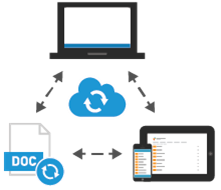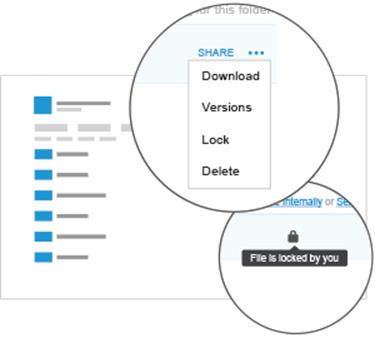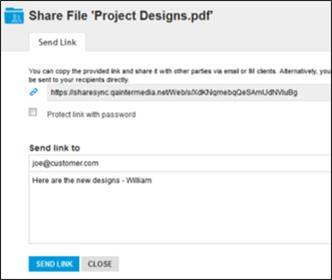Business-grade file sync and share
ShareSync is a cloud file sync and share service. ShareSync allows you to easily sync files between multiple computers, the ShareSync web portal and mobile devices so that you can access your files whenever and wherever you need them. With ShareSync, you are also able to securely share your files with your co-workers and external collaborators, like business partners or clients.

Once ShareSync is installed on a computer, it creates a designated “sync” folder called My ShareSync in the Documents folder and adds it to Favorites in Windows Explorer. All files and folders added to the My ShareSync folder are automatically synced to the cloud as well as all the user’s devices where ShareSync is installed.
ShareSync beats file servers
ShareSync offers greater mobility, control, and integration.
File servers are one of the most important parts of an office’s IT infrastructure. They are critical for facilitating access to a central file repository. That’s why they are so popular in the small business world.
But file servers create as many problems as they solve. Chief among them is cost: not only is the hardware expensive to purchase, maintain and upgrade, but a file server costs a fortune to run. According to ZDNet, a typical file server drains over $700 worth of electricity every single year.
In the past, people accepted the shortcomings of file servers because there was no alternative. But the cloud has changed all that. Here are five reasons why on-premises file servers hinder small businesses more than they help, and why you should consider the business-grade solution, ShareSync from DIVERSE CONCEPTS.
1. File servers are high-cost and low-agility.
File servers are machines, and machines need maintenance and upgrades. Plus they need an IT staff to administer them, as well as real estate to house them. All this adds up to significant expense. What happens when your company expands? That’s more money and more resources lost in building out more server space or spent on ongoing hardware, backup and OS upgrades. Simply put, file servers can suck up precious capital that you need for other things.
2. You get no uptime guarantees.
Most cloud services guarantee 99.9% uptime (and the best of them guarantee 99.999% uptime.) If you’re running an on-premises file server, you almost certainly can’t afford to build the redundancy and availability found in cloud datacenters. How much would it cost your business if you can’t access your files for an hour? How about for a whole day? Food for thought: According to VentureBeat, about 73% of businesses have had some type of interruption in the past 5 years.
3. File servers aren’t made for a mobile workforce.
Today’s mobile workforce needs immediate access to their data, no matter where they are or what device they’re using. With a file server, “mobile” access requires logging on to a VPN on a laptop or going through the hassle of configuring a mobile device connection. And even then, you might not get it to work with all devices. If you need file access at your fingertips, a file server can’t deliver.
4. Sharing files externally is complicated, if it’s possible at all.
These days, customers and partners often need to view or collaborate on files, too. But your file server may not provide this capability. If it does, it’s not going to be easy to set up. Regardless, building the functionality is going to force you to invest even more in software, hardware, and IT time.
5. Collaborating on files gets tricky.
What happens when two people both need to work on a file? How do you prevent one person from overwriting the work of the other? With file servers, you don’t have control over versioning and overwriting. Multiple copies of the same data take up precious storage space; users upload and download with abandon; data gets moved or lost. It’s chaos, and it eats up revenue and frustrates your workforce.
If file servers can’t meet the demands of today’s businesses, what are the alternatives? Moving your company to a cloud-based file sync and share service may be best for your documents, company and wallet.
Be sure to look for cloud-based file sync and share tools that can provide the same functionality as a file server—but without the detractions. Again, consider ShareSync from DIVERSE CONCEPTS. ShareSync lets you offload hardware and software maintenance to lower your costs, and they also deliver anywhere-access and collaboration features that file servers can’t match. Bottom line: your business deserves more than your file server.
Compare ShareSync to other products
|
|
ShareSync |
Box for Enterprise |
Box for Business |
Dropbox for Business |
|
Included storage |
10 GB |
Unlimited |
1 TB/ Acct |
200 GB |
|
Max file size |
Unlimited |
2 GB |
2 GB |
Unlimited |
|
Support for all PC/Mobile platforms |
Yes |
Yes |
Yes |
Yes |
|
Granular sharing permissions |
Yes |
Yes |
Yes |
No |
|
Sub-folder sharing |
Yes |
No |
No |
No |
|
Group Sharing |
Yes |
Yes |
No |
No |
|
Free Secure External Sharing and Collaboration |
Yes |
$35/user |
$15/user |
Insecure |
|
In-transit/At-rest encryption |
Yes |
Yes |
Yes |
Partial |
|
Account-level encryption key |
Yes |
Yes |
No |
No |
|
Lock files for editing |
Yes |
Yes |
Yes |
No |
|
Active Directory integration |
Yes |
Yes |
Yes |
Yes |
|
Office/Outlook integration (Windows) |
Yes |
Yes |
Yes |
No |
|
Full-text Search (web/mobile) |
Yes |
Yes |
Yes |
No |
|
Remote wipe of data |
Yes |
Yes |
No |
Yes |
|
Audit Log of all events |
Yes |
Yes |
Yes |
Yes |
|
One-stop Shop for Cloud Services |
Yes |
No |
No |
No |
|
99.999% Uptime SLA |
Yes |
No |
No |
None |
Sync Files
 Files are automatically synced across all devices
Files are automatically synced across all devices
-
- Sync files across desktop, mobile devices, and the web
- Support for Windows and Mac with familiar drag-and-drop functionality
-
Mobile apps for iPhone, iPad, and Android
- Files and folders are available from any web browser
Share Folders
 Easily share folders for collaboration
Easily share folders for collaboration
-
- Share folders with co-workers or external users with one click
- Share directly from the corporate address book
- Control access with “Co-Owner,” “Modify”, and “View” permissions
- Modify permissions at any time
- Set different permissions for sub-folders
- Change to files in shared folders are automatically synced
- Easily share content with groups using Exchange Distribution Lists
Share Files
 Share files with anyone via web link
Share files with anyone via web link
-
- Any ShareSync file can be shared with anyone
- Files can be viewed even if the recipient doesn’t use ShareSync
- Can be shared using the Send Link function from the ShareSync web portal, or by copy/pasting the link into email
- Links are secure, but can be further protected with a password
Features
ShareSync desktop client works on all currently supported versions of Windows and Mac OS.
Integration
- Desktop integration
- Windows Explorer and Mac finder
- Outlook and Office Integration for Windows
- Manage files directly from most frequently-used applications
- Integrated with Active Directory
- Easy file sharing by first or last name
- Mobile device Integration
- Open, edit, and save ShareSync files
Security
- At-rest and in-transit data encryption
- Unique encryption key per customer account
- Password protection, integrated with AD password policies
- Remote wipe of ShareSync data (including desktops)
Administration
- Managed from Control Panel
-
- Enable/manage users
- View/manage storage
- View/manage ShareSync devices
- Set retention policies
- Audit log
Office Plugins
 You can enable plugins for Microsoft Office and Microsoft Outlook that allow you to manage files and folders directly from within these applications.
You can enable plugins for Microsoft Office and Microsoft Outlook that allow you to manage files and folders directly from within these applications.
The Microsoft Outlook plugin will allow you to easily replace email attachments with web links that open files using ShareSync. This is useful when sharing large files over email and when sharing large files with people outside your company, and especially so if attachments are larger than the maximum limit imposed by an email system.
A familiar scenario?
You’re at an off-site meeting, but left an important document back at the office.
It takes you hours to consolidate reports and updates from your team.
You edited an entire document, only to realize you didn’t see the email with the newer version.
Your new client cannot receive emails with large file attachments.
That your users are putting company data on services you cannot see and cannot manage.
WOULDN’T YOU RATHER BE MANAGING YOUR BUSINESS?
ShareSync significantly reduces the amount of time you and your employees spend on managing files and folders.
